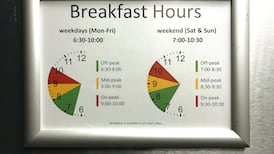On Monday, Dublin's Project Arts Centre announced it had removed a mural from the front of its premises on Essex Street in Temple Bar. The jaunty red and white image, painted by street artist Maser, featured a large heart and the logo "Repeal the 8th". Project painted over it after receiving a warning notice from Dublin City Council Planning Department that the work was in violation of planning law. The centre says it's now working "through official channels" with Maser and The Hunreal Issues (the website which commissioned the piece) to explore the possibility of re-installing this work as soon as possible."
Project said it had received over 200 letters of support and 50 complaints about Maser’s painting. As is the way with these things, competing online campaigns for and against the mural had sprung up in the days since it first appeared. Angry tweets were posted. Hashtags were deployed. Twibbons were distributed. The image of the red logo being obliterated by blue paint has been used as a visual metaphor for Ireland’s denial of women’s reproductive rights.
All of which suggests Maser’s mural has already succeeded admirably in its objective of keeping the campaign to repeal the Eighth Amendment in the public eye, probably far more so than if it had just remained in situ.
Project has featured a political message on its facade before - a large “Yes” painted by Sumsone adorned the building during last year’s marriage equality referendum – but this is the first time it’s been found to be in breach of regulations. According to Dublin City Council, That painting was deemed an exempted development, “as it was erected in connection with a referendum as allowed for under the Planning and Development Regulations 2001”. The council, which received seven complaints about Maser’s mural, said the regulations allow for “the painting of any external part of any building or other structure” but the painting shall not “be for the purposes of creating a mural”.
Judging by the council’s explanation, when the Irish people do finally get to vote on replacing or removing the Eighth Amendment, Project will be free to put anything it wants on its walls. In the meantime, it should really clarify what it can or can’t do legally with its facade.
Condemned
The decision to paint over the picture has been condemned as censorship and an attack on free speech. However, it seems to be a pretty straightforward legal issue, although it would be interesting to know how many of the murals adorning pubs and other commercial premises around the city have been officially approved. In principle, though, it makes eminent sense for the council to exercise its powers to restrain companies or individuals from turning their properties into giant billboards – whatever their message - without going through some sort of legal process. It’s perfectly possible to support the sentiment of Maser’s mural while finding the argument that works of art should be exempted from such regulations pretty unconvincing.
There’s also a certain irony in the fact that Maser’s artistic practice is rooted in graffiti culture – which is by definition provisional, illegal and subject to brutal erasure. What better fate for agitprop of this sort than to stir up controversy and debate before being painted over?
Hugh Linehan is Culture Editor










